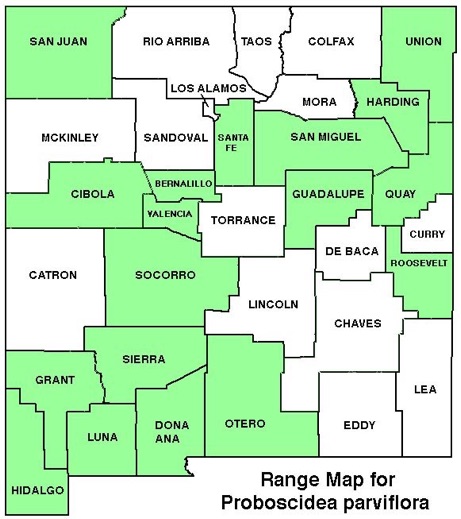WILDFLOWERS OF NEW MEXICO

Low spreading and 2-feet tall and 4–6-feet wide, this hairy plant has fleshy stems, bizarre forked seedpods, and is densely covered with large, sticky, musky-smelly leaves. Note the pinkish-white to reddish or magenta, bilaterally symmetrical, orchid-like flower with no internal spots on upper lobes. Proboscidea was formerly classified in the Sesame family, Pedaliaceae.
FLOWERS: June–October. Clusters of up to 10 on a hairy, 4-inch (10 cm) long spike bloom a few at a time. United petals form a funnel-shaped tube 5/8–1 1/2-inches (15–35 mm) long and wide with 5 petal-like lobes that vary from reddish-pink, magenta, to whitish; lower lobe has a broad, yellow nectar guide; 2 upper lobes have a broad purple splotch but no spots. The bizarre fruit ripens as a 3–4-inch long okra-like pod, about 1-inch thick, and tapering to a hooked point. When dry, the end of the pod splits open with two woody, curved spines with sharp hooks.
LEAVES: Opposite. Blades heart- to kidney-shaped, 10-inches (25 cm) long and wide; margins entire to lobed. Glandular hairs make the leaves smelly and sticky.
HABITAT: Sandy, gravelly soils, drainages, roadsides, disturbed areas; desert grasslands and scrub, pinyon-juniper grasslands.
ELEVATION: 4,000–6,500 feet.
RANGE: AZ, CA, NV, NM, TX, UT.
SIMILAR SPECIES: 4 species of devil’s claw in NM. Unicorn Plant, P. louisianica, in the eastern plains, has purple spots on the upper and lower flower lobes; P. sabulosa, rare in sand dunes of se counties, has a 3/8-inch (1 cm) wide flower; P. althaeifolia (see photo), in southern 1/2 NM, has yellow flowers.
NM COUNTIES: Desert scrub habitats of Bernalillo, Cibola, Dona Ana, Grant, Guadalupe, Harding, Hidalgo, Luna, Otero, Quay, San Juan, San Miguel, Santa Fe, Sierra, Socorro, Union, Valencia.
NOTES: The Hohokam O'odham Indians of Arizona domesticated Devil's Claw (P. parviflora var. hohokamiana) to use the pods for the intricate black designs in their traditional baskets. They developed other varieties that had seedpods with fifteen inch-long claws, and one with four claws. Allegedly the seeds have a nutty flavor and are highly nutritious, and the small, tender pods can be pickled or boiled like okra.









DEVIL’S CLAW
PROBOSCIDEA PARVIFLORA
Unicorn Plant Family, Martyniaceae
Annual herb









THE CONTENTS OF THIS WEBSITE ARE COPYRIGHTED AND CANNOT BE USED
WITHOUT PERMISSION OF GEORGE OXFORD MILLER
















































































SIMILAR SPECIES
Left: Unicorn Plant, P. louisianica, in the eastern plains, has purple blotches on the upper lobes.
Right: Desert Unicorn Plant, P. althaeifolia, in southern NM, has yellow flowers.










Photo: Petroglyph National Monument, Albuquerque, NM
Upper lobes are dark purple. Photo: Petroglyph National Monument, Albuquerque, NM
The ripe fruit pods (left) dry and split open with two claws (right) that snare on animals and disperse the seeds.









EMAIL ME







